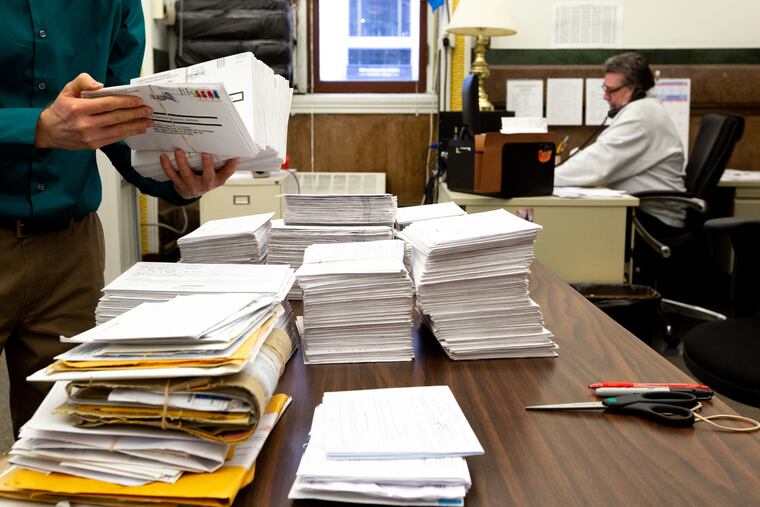How tight are Pa.’s absentee-ballot deadlines? The rate of late ballots is 11 times the nation’s.
Gov. Tom Wolf is drafting a bill that would extend the deadline by a week.

Pennsylvania’s absentee-ballot deadlines are so strict that mail-in ballots arrived late in 2018 at a rate 11 times higher than in the rest of the nation, according to data on votes cast.
As turnout surged in the midterm election, 4.2% of Pennsylvania absentee ballots arrived after the deadline, compared with 0.38% nationwide.
Gov. Tom Wolf wants those deadline rules loosened, state spokespersons said Thursday.
The number of late ballots was so high that while the state accounted for just 0.6% of the total absentee ballots submitted nationwide, it had 7.2% of the late ones.
Pennsylvania voters submitted 186,664 absentee ballots in 2018; of those, 8,714 were rejected. Nearly all — 8,162 — were rejected because of a missed deadline, according to data released last month by the U.S. Election Assistance Commission. Only Delaware had a higher missed-deadline rate.
Pennsylvania has been near the top of the pile for a while, with the state’s voters missing deadlines at rates far greater than those in most other states. And it was clear soon after the 2018 election that the trend had continued — and even worsened.
» READ MORE: Thousands of absentee ballots were rejected as record turnout encountered Pa.’s tight deadlines
That was confirmed by the EAC data, the most complete and detailed of accounting of votes cast across the nation in the midterm election. The numbers aren’t perfect, however. They are self-reported by county and state election officials. In fact, the EAC numbers appear to undercount Pennsylvania’s late ballots by at least 1,400.
Bucks County, which had hundreds of late ballots, is listed as having zero; Philly had more than 1,000, but is listed as having 378; Allegheny County lists zero. Counts for other counties appear to be accurate.
(These figures are for civilian voters in the United States; overseas civilian and active-duty military voters have a different process and timeline.)
Wolf is working on legislation that would allow “no-excuse” absentee voting; extend in-person delivery of absentee ballots by three days; and extend the mail-in deadline by one week, spokesperson J.J. Abbott said Thursday.
“The governor believes the current absentee ballot system is archaic and out of touch with the lives of modern voters,” Wanda Murren, spokesperson for the Pennsylvania State Department, wrote in an email.
Absentee ballots are rejected for a variety of reasons, including missing signatures or invalid envelopes. Nationally, just over a quarter of rejected absentee ballots were for missed deadlines.
The deadlines
In Pennsylvania, voters have until one week before an election to request an absentee ballot, which is mailed to them. The filled-out ballot must be returned by mail or in person by 5 p.m. the Friday before the election.
That gives voters just three days between the application and submission deadlines; if mail takes two days to travel from elections officials to the voter, and then two days to travel back, the ballot arrives after the deadline and is rejected.
» READ MORE: Pa.’s absentee-ballot problem: Votes come in late because of tight deadlines
It’s a problem that elections officials say is exacerbated by changes to postal delivery in recent years. Last year’s missed-deadline rate was higher than in 2014, when 86% of rejected absentee ballots arrived after the deadline.
The future
The deadline issue has gained attention in recent years.
State Rep. Tina Davis, a Bucks County Democrat, challenged the deadlines in court last year after barely losing a state Senate race, but the lawsuit was dismissed without explanation.
The ACLU of Pennsylvania sued the state last year with a group of voters who tried to vote absentee in November, but whose ballots arrived after the deadline. They were joined by lawyers from the national ACLU, the Lawyers’ Committee for Civil Rights Under Law, and the Philadelphia-based Public Interest Law Center.
» READ MORE: ACLU sues over Pa.’s tight absentee ballot deadlines
They argued that the deadlines violate the state Constitution’s guarantee that elections “shall be free and equal” and the Equal Protection Clause of the 14th Amendment to the U.S. Constitution. A panel of judges is deciding whether to allow that case to proceed.
Some lawmakers also have expressed interest in changing the deadlines.
Last month, Republican lawmakers passed an election bill that would have made a variety of changes, including significantly changing absentee-ballot deadlines. But it included provisions that Democrats railed against, including proposed elimination of the straight-party voting option that Democrats said would confuse voters and complicate the act of casting a ballot. Wolf vetoed the bill.
The deadlines’ effect on the 2020 presidential election will be minimal. By law, absentee ballots that arrive after the state deadline but before polls close at 8 p.m. on Election Day will be only partially counted. So while the increased turnout in the presidential election is highly likely to mean more absentee ballots arrive after deadline, those votes will count for president — but for no other office.